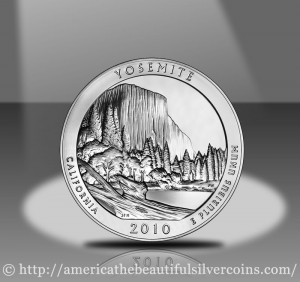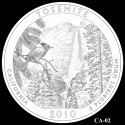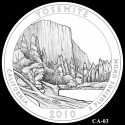The 2010 Yosemite America the Beautiful Silver Bullion Coin is the third in a new series of celebratory coins with reverse designs honoring a U.S. National Park or National Site. This coin honors Yosemite National Park in the state of California.
These coins were released by the US Mint for order by its network of authorized purchasers on December 10, 2010. By the end of the month, the entire mintage of 33,000 had been ordered with plans underway for those strikes to be resold by the network to the public for a small premium above the current spot price of the five ounces of silver contained within each. Of note, the other four 2010-dated strikes of the series were also released on December 10, 2010 and sold out later that month as well.
The silver bullion coins are companions to the new U.S. Mint America the Beautiful Quarters® series. In fact, each one minted is a duplicate of the corresponding quarter, with the exception of the .999 fine silver metal composition, massive diameter of three inches, five ounce weight, and special edge inscriptions.
To illustrate proportions, the Yosemite America the Beautiful Silver Bullion Coin is nearly twice the size of today’s American Silver Eagle with its 1.598 inch diameter. (The silver eagle is the only other silver bullion coin struck by the United States Mint.)
2010 is the inaugural year for the quarters and silver coins. Sites to be honored have already been selected from each state, the District of Columbia and U.S. territories — Puerto Rico, Guam, American Samoa, the U.S. Virgin Islands and the Northern Mariana Islands. At a rate of five releases per year, the series will last until 2021.
The America’s Beautiful National Parks Quarter Dollar Coin Act of 2008, which authorized the series, mandated that their designs be submitted to the Citizens Coinage Advisory Committee (CCAC) and the United States Commission of Fine Arts (CFA) for review and comments. The act also required the designs to be emblematic of the sites they were designated to portray.
Prior to the selection of the final design for the Yosemite Silver Bullion Coin, shown above, the two bodies reviewed four candidates. These, in line art image form, are shown below along with accompanying CCAC and CFA comments. Each image may be enlarged with a click:
The CCAC selected the design candidate denoted as CA-03, stating:
"For the coin portraying Yosemite National Park in California, the Committee prefers design 3, featuring a view of El Capitan," the CCAC reported to Treasury Secretary Geithner. "Members praised the simplicity and ruggedness of the design, and its effective composition."
The CFA selected design candidate CA-04, saying:
"The Commission recommended alternative #4 depicting the Half Dome rock formation, with the comment that the artwork appears unfinished and should be further developed," CFA Secretary Thomas E. Luebke said in a report to US Mint Director Ed Moy. "The Commission suggested that other historic sources, such as the photographs of Ansel Adams, be considered in refining this image."
The Secretary of the Treasury is responsible for selecting the final design for each site’s coin. The Mint formally unveiled all the 2010 America the Beautiful Silver Coin designs on March 24, 2010. The one chosen for Yosemite is represented by candidate CA-03 above.
Bullion coins are not directly available from the U.S. Mint (http://www.usmint.gov/). Instead, the Mint sells them to a network of authorized buyers who then resell them to the coin dealers, collectors, precious metal providers, etc. The price these resellers charge is usually a slight premium over the current spot price of silver at the time.
The United States Mint will also be releasing a collector grade version of this coin known as the Yosemite Silver Uncirculated Coin.
Yosemite National Park in California
Yosemite National Park in California is best known for its waterfalls, granite cliffs, ancient giant sequoias, deep valleys, and grand meadows. The park has nearly 1,200 square miles of natural beauty.
Around 10 million years ago, the Yosemite area was uplifted and tilted, forming the relatively gentle slope of the land. Then, around 1 million years ago giant glaciers started to contour the massive valleys out of the granite hills.
The Yosemite Grant was signed by President Abraham Lincoln in 1864, setting aside the land for public use. However, it failed to protect the area as much as was hoped because it left control to the State of California. Powerless to evict homesteaders, the board controlling Yosemite achieved little to aid the fragile area.
Then naturalist John Muir camped with President Theodore Roosevelt near Glacier Point during which he extolled the virtues of Yosemite. Roosevelt signed a bill in 1906 placing Yosemite under the control of the federal government.
Annually, an estimated 3.5 million visitors travel to Yosemite National Park. Most go to Yosemite Valley to see the granite El Capitan and the more famous Half Dome.




